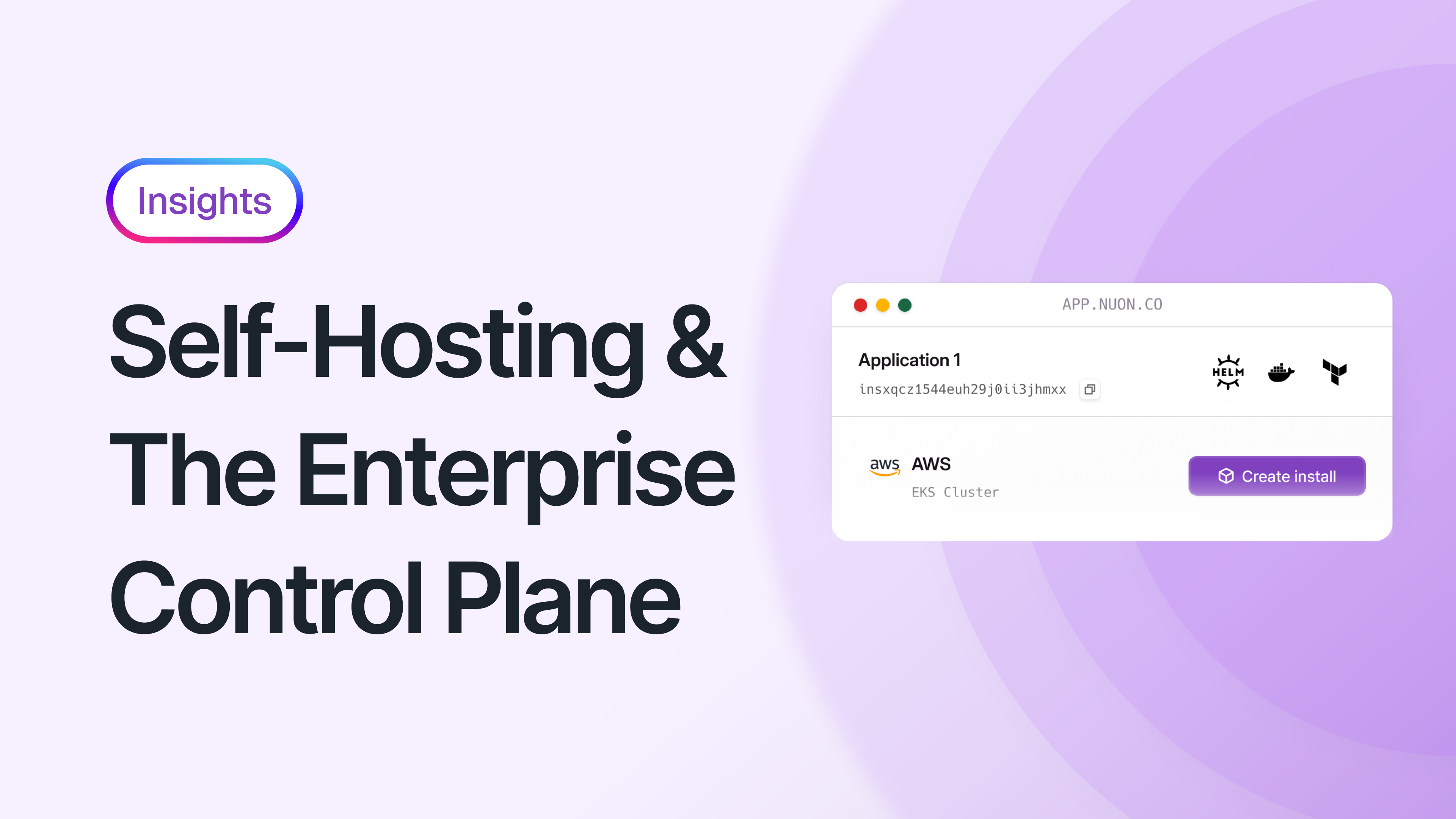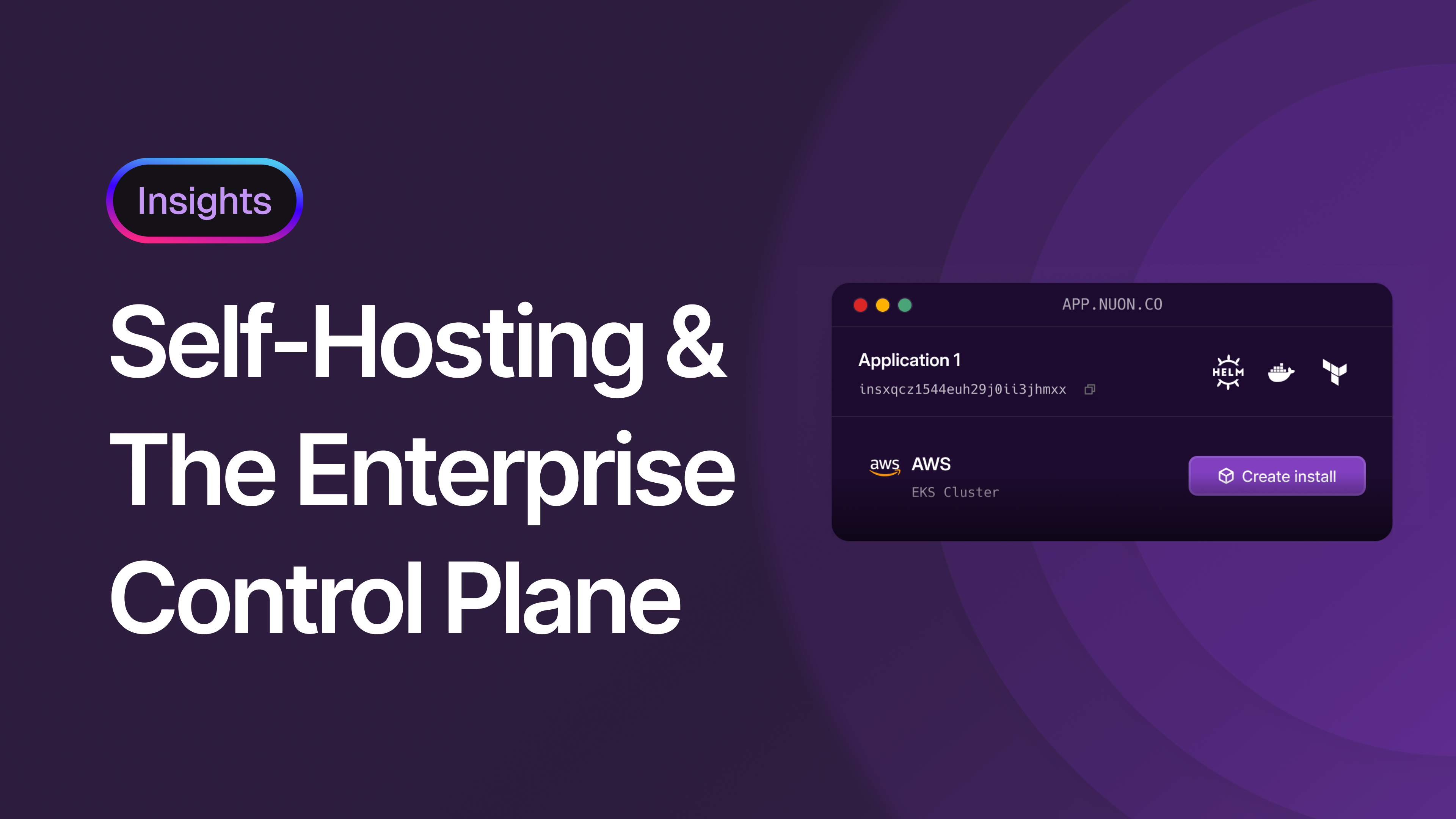A Better Form of Self-Hosting: The Enterprise Control Plane Model
This blog post defines a new paradigm — the “Enterprise Control Plane” — where enterprises use a centralized layer like Nuon to manage how software vendor and in-house apps are packaged, installed, operated, and monitored across cloud providers.

Mark Milligan
VP of Revenue


For many Fortune 500 and government organizations including banks, regulated industries, and government agencies, self-hosting isn’t a preference — it’s a policy. Security, compliance, and data-sovereignty rules often prohibit sensitive data from residing in a vendor’s cloud, making in-network deployment the only acceptable model.
Defining Self-Hosting
In this context, self-hosting means the enterprise runs applications in its own controlled cloud or on-prem infrastructure, rather than in a vendor-managed environment. While this approach satisfies security and compliance mandates, it also forces platform and operations teams to take on the full burden of deploying, maintaining, and upgrading every app themselves.
Enterprise Multi-Cloud Strategy
Enterprise leaders recognize the risks of relying on a single cloud provider. Vendor lock-in is real — with limited leverage on pricing and few safeguards against unexpected increases. There’s also the risk of a single point of failure, underscored by recent large-scale cloud outages across major providers.
App Sprawl
As these enterprises have adopted multi-cloud strategies for risk mitigation and cost control reasons, that burden has only grown. Most enterprises now operate across several providers — AWS, Microsoft Azure, Google Cloud Platform, Oracle Cloud Infrastructure, and IBM Cloud — each with its own identity model, networking constraints, deployment primitives, and security frameworks. Every application must be adapted to these nuances, creating a patchwork of scripts, Terraform modules, and one-off install processes that vary by team and cloud. What begins as a compliance requirement quickly becomes an operational maze, with platform teams spending more time managing environments than enabling innovation.
Day-2 Operations
There is often too much emphasis on the provisioning/de-provisioning or install/uninstall part of the software lifecycle. Day-2 is the term for anything that has to occur after the app install. There's observability, scripts and CI to upgrade apps, what happens when you need to repair apps, and the security aspects of this. Should platform teams have constant, elevated permissions to these production apps?
Terraform’s Natural Boundaries
While Terraform is a foundation for how a lot of enterprises provision infrastructure, it was never meant to operate as a complete control plane. Terraform state captures what was deployed, but not the context around it. Once systems are running, teams often rely on custom scripts to perform health checks, troubleshoot, patch, or adjust configurations — actions Terraform doesn’t record or manage.
Self-Hosting Is Not Necessarily Secure
While self-hosting applications within an enterprise’s own cloud accounts provides a layer of protection, it doesn’t automatically make those deployments secure. The way applications are installed, upgraded, and maintained can still expose risk — particularly when a single administrative role holds broad permissions across the entire lifecycle of provisioning, maintenance, and teardown. A more secure approach would segment these duties, granting least-privilege access for each stage of an application’s lifecycle. And although cloud providers log resource events, those logs are scattered across services and lack a unified, app-centric view — making it difficult to trace who did what, and when, for a given installation.
A Better Model for Enterprise App Management
Enterprises need more than infrastructure automation. They need a standardized and unified way to package, install, operate, and monitor the hundreds to thousands of apps across the enterprises' cloud providers. Nuon provides a unified control plane where the Platform and DevOps teams more easily and quickly get apps installed and maintained, while re-using existing Terraform, Helm charts, Kubernetes manifests, container images, and healthcheck, debug and configuration scripts.
Self-Hosted, But Secure & Logged
“God mode” or single roles with broad, elevated permissions are not ideal for installing and operating enterprise applications — whether developed internally or sourced externally. Nuon employs a granular, segmented security model where the runner is deployed within the target cloud account and securely communicates with the Nuon control plane to receive installation and day-2 operation tasks. Each runner operates under distinct roles with clearly defined permission boundaries aligned to the application’s lifecycle. For example, installation and de-provisioning require the highest privileges to create and remove resources, while routine operations and upgrades run with restricted permissions. Runners can even be remotely shut down, preventing any further modification of cloud resources and ensuring complete administrative control.
Governance, Compliance, and Observability
Security doesn’t end with access control — it depends on visibility. Every installation, upgrade, rollback, and operational action performed through Nuon is automatically logged and correlated to a specific application, cloud account, and operator identity. This provides a unified, application-centric audit trail that most cloud logs cannot offer on their own. Instead of stitching together fragmented records from AWS CloudTrail, Azure Activity Logs, or GCP Audit Logs, teams gain a centralized view of the entire application lifecycle. These logs are exportable for compliance and incident analysis, helping enterprises meet regulatory and internal governance standards while maintaining operational agility.
Enterprise Change Controls
Installing and operating an application involves modifying foundational cloud resources, which often requires human oversight and explicit authorization. Nuon supports this by allowing components — such as Terraform, Helm, and Kubernetes manifests — to be reviewed and approved by a user before execution. Administrators can also configure installs to auto-approve all components when appropriate. If infrastructure changes occur outside of Nuon, built-in drift detection can run periodically to identify and notify users of any differences between the defined and actual environments. We’ll be sharing more details about this capability soon — stay tuned.
Standardizing How Applications Are Defined
Before Nuon, enterprise platform and DevOps teams often had to dig through documentation, internal wikis, and ad hoc scripts just to understand how to install or operate an application. With Nuon, each application is defined through a uniform set of .toml configuration files that reference Git repositories containing Terraform, Helm charts, and Kubernetes manifests that enterprises may already have built. Like the control plane itself, the configuration is centered on the application — its components, lifecycle, and operational scripts. These configs also define day-2 operations such as health checks, debugging routines, and one-off “break-glass” repair actions, all expressed as reusable scripts called actions. Even installation steps, like initializing a database, are part of the configuration. When onboarding a new application, teams can build on existing app configs — reusing proven best practices, installation logic, and operational standards across the enterprise.
Standardizing Multi-Cloud Deployment
Standardizing how applications are defined makes it far easier for enterprises to install and operate software across their various cloud provider accounts. Each cloud is different — with its own APIs, networking models, and security frameworks — which naturally creates hesitation or friction when adopting more than one. Nuon simplifies this by breaking application configurations down to first principles. Cloud-specific building blocks, such as Kubernetes resources or Terraform modules, can be templated for each provider, while the rest of the configuration remains reusable and consistent. In practice, this means teams can maintain multiple versions of an app configuration — one per cloud or environment type, such as dev, test, or prod — and deploy to any region with minimal rework. Security and risk teams benefit too: applications can be deployed across multiple clouds in a standardized, auditable way, reducing operational risk and eliminating single points of failure.
How Both Enterprises and Software Vendors Benefit
Both enterprises and software vendors have strong reasons to adopt Nuon for their application deployment and management needs. We’re seeing particularly strong interest from enterprises, who tend to prefer implementing proven third-party platforms that deliver value quickly rather than building and maintaining complex systems internally. Software vendors, by contrast, often have deep engineering expertise and could build something similar in-house — but many are choosing Nuon instead for its built-in multi-cloud support, security model, and operational visibility, allowing them to stay focused on improving their software rather than the infrastructure around it. Looking ahead, we’re exploring capabilities that will allow Nuon app configurations and install states to be exported or imported between enterprise and software vendor environments, enabling enterprises to delegate or transfer app management seamlessly when needed.
Bringing It All Together
Enterprises want control, consistency, and security — but they also want to move faster. Nuon gives them a way to do both. It brings the reliability of infrastructure-as-code and the visibility of a centralized control plane into one workflow that works across clouds, teams, and applications. Whether you’re deploying your own in-house built software or installing a software vendors, Nuon standardizes how it’s done, tracks everything, and keeps it secure. The result is a consistent, secure, operational model across clouds — one control plane to package, install, operate, and monitor every application you run.
If this sounds like something your team has been trying to build, you can deploy your first app on Nuon in minutes — no credit card required. Click here to get started, or join the conversation in Nuon’s Slack community.